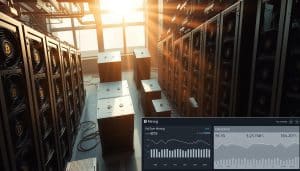Over $3.87 billion flowed into Ethereum ETFs recently. This shows institutions are putting lots of money into Ether, changing how to safely buy Ethereum in 2025. Arkham Intelligence has spotted big buys of ETH. Coinbase is mixing crypto and ETF products. These actions change the market and highlight the need for a secure Ethereum exchange.
My advice comes from real tests: looking into trading volumes, checking fees, and evaluating security on platforms like Coinbase, Kraken, Binance.US, and others. This guide will reveal the top platform for buying Ethereum. It’ll focus on how they hold your assets, follow laws, and offer a good user experience. You’ll learn the safest ways to get Ethereum, the most trustworthy places to buy it, and tips for picking a secure seller.
The information here is practical and easy to follow. I’ll guide you through setting up, comparing fees, choosing wallets, and securing your account. My findings are backed by sources like Arkham Intelligence, ETF reports, and statements from regulators like the SEC and CFTC. This lets you make informed decisions without falling for the hype.
Key Takeaways
- Institutional ETF inflows and whale buys have improved ETH liquidity — pick exchanges that handle large orders.
- Prioritize a secure Ethereum exchange with clear custody options and strong regulatory compliance.
- Fees and order-book depth vary widely; compare real trade costs, not just headline fees.
- Use a combination of custodial exchange services and hardware or non-custodial wallets for safety.
- Follow simple security steps now: strong passwords, 2FA, and verified domain checks before trading.
Introduction to Purchasing Ethereum Safely
I’ve been involved with ETH since the Merge. This intro explains what Ethereum is, why its market structure is vital, and how to identify risks. It’s all about clear explanations, known dangers, and the methods I use myself.
Understanding Ethereum and Cryptocurrencies
Ethereum is a blockchain that can run smart contracts and issue tokens. ETH is used to pay for transactions, secure the network, and run apps. It’s important to know ETH’s role when looking at trading and investment options.
When you own ETH directly, that’s spot trading. Derivatives and ETFs let you invest without holding ETH yourself. Order books reflect buying and selling interest, and liquidity shows how easy it is to buy or sell. I keep an eye on ETF trends as they can influence where to buy Ethereum safely.
Importance of Safe Transactions
Buying ETH comes with risks like exchange hacks and scams. Exchanges and wallets can be targets. Custodial exchanges keep your keys, which is simpler but risky. With a non-custodial wallet, you manage your keys, adding security but also responsibility.
I favor regulated exchanges like Coinbase or Kraken for starting. For long-term holding, I use a hardware wallet or trusted non-custodial wallets. This approach makes buying Ethereum safer.
I watch for signals from regulators and market movements. New products like futures or custody services show the market is growing. These are promising signs for secure Ethereum exchanges.
Before any transaction, I make sure the website is real, turn on two-factor authentication, check the exchange’s insurance, and understand transaction finality. These steps ensure I buy Ethereum safely.
| Topic | Practical Point | Why It Matters |
|---|---|---|
| Custody Choice | Use Coinbase or Kraken for fiat buys; move long-term to Ledger or Trezor | Balances convenience with control; reduces exposure to exchange breaches |
| Market Type | Spot ownership vs ETFs and derivatives | Spot gives on-chain control; ETFs change liquidity and institutional access |
| Security Checks | Verify domain, enable 2FA, confirm insurance, watch social channels | Mitigates phishing, SIM-swap, and social-engineering attacks |
| Network Mechanics | Check gas, finality, and staking implications | Helps time transactions and choose custody based on staking rules |
| Signals to Watch | Regulatory remarks, ETF inflows, on-chain whale moves | Indicates shifts in liquidity, platform offerings, and market behavior |
Current State of the Cryptocurrency Market
I keep an eye on the market and make notes for buyers. The crypto world in 2025 is buzzing more than ever. Big players and companies are moving money around, affecting decisions on where to buy Ethereum safely 2025 for big transactions.
Whale actions and ETF movements have made some weeks very busy. For everyday traders, this means more options on major exchanges. For people investing on their own, it’s key to check for safety and rules before picking a place to buy Ethereum.
Overview of Market Trends in 2025
Whales have caused big shifts in prices and market fluidity. One huge account sold $215 million in Bitcoin for about 886,371 ETH. Arkham Intelligence noticed big amounts of ETH being bought, tightening the gap in prices, important for buying Ethereum safely 2025.
ETFs have changed how money is put into crypto. Recent data showed a big move from Bitcoin to Ethereum products. This made traders and big investors think differently about their investments. Watching these trends helps buyers stay ahead.
Key Statistics and Predictions for Ethereum
Here are some important numbers I watch. They show how market interest and risk are changing. These can help you choose where to trade large amounts safely.
| Metric | Value | Relevance to Buyers |
|---|---|---|
| BTC Price | $109,380 | Macro benchmark that often leads crypto sentiment |
| 24h BTC Volume | $66,000,000,000 | Indicates overall market liquidity and trading activity |
| ETH ETF Inflows (recent month) | $3,870,000,000 | Shows growing institutional preference for ETH exposure |
| BTC ETF Outflows (recent month) | $751,000,000 | Signals rotation from BTC to alternative crypto products |
| Whale ETH Accumulation | ~$2,500,000,000 | Large buys that can support price and tighten spreads |
| Noted Large Trade | ~886,371 ETH bought via BTC sale | Example of cross-asset rotation impacting ETH demand |
My future view for Ethereum in 2025 sees more big investors and ETFs joining. The rise of DeFi and staking will push demand up. Prices could stay up if big buyers keep focusing on ETH and ETFs attract more investment.
Yet, risks are out there. The US dollar’s strength and global market changes could sway money towards stocks or bonds quickly. Also, small, risky tokens are still getting attention. This means some risky trades will happen alongside more stable Ethereum trades, keeping the market lively.
When buying, pick exchanges that are safe, stick to the rules, and have solid trading volumes. Those places can handle big trades and let you move confidently with the market trends of 2025. Keep these Ethereum predictions for 2025 in mind but trade wisely and within your limits.
Choosing the Right Platform to Buy Ethereum
I’ve been checking out places to buy Ether for years. The question is: Do you prefer ease or control? Finding the right mix of easy money access and safe keeping is key for your first ETH purchase.
I’ll tell you about the platforms I like, focusing on their safety and how easy they are to use. For many in the U.S., finding a trustworthy place to buy Ethereum is key. Big trades get better support and less price movement from institutional desks.
Top platforms I recommend testing first:
- Coinbase — regulated U.S. presence, easy fiat on-ramps, insured custody for certain assets.
- Gemini — U.S.-focused compliance and clear regulatory posture, strong KYC/AML flows.
- Kraken — long-standing security reputation and transparent proof-of-reserves efforts.
- Binance — deep liquidity and many trading products, but check regional compliance status before use.
- Institutional desks (Coinbase Prime, Kraken OTC) — best for block trades and reduced market impact.
Cloud-mining and other options need careful thought. They can open doors to Ethereum’s world, but aren’t the main way to buy ETH with cash. Keep your mining and direct ETH buys separate.
Features to vet on any platform:
- Regulatory standing and visible licenses, for example FinCEN registration in the U.S.
- Clear KYC/AML procedures and responsive customer support.
- Custodial insurance and documented cold-storage practices.
- Proof-of-reserves audits or third-party attestations.
- Transparent fee schedules, order-book depth, and withdrawal limits.
- Availability of ETH staking and easy withdrawal to hardware wallets.
When you’re choosing, look at their security history, how they handle money, their fees, and how easy they are to use. A good Ethereum exchange will be open about any issues they’ve had and how they fixed them. This honesty is a good sign.
If you’re buying Ethereum for the first time in the U.S., try starting with Coinbase or Gemini. These places make adding money easy and keep things smooth. Then, move your long-term investment to hardware wallets like Ledger or Trezor for the best safety.
| Platform | Strength | Best Use Case |
|---|---|---|
| Coinbase | Regulated, easy fiat on-ramp, insured custody | Beginners and retail buyers in the U.S. |
| Gemini | Regulatory-first, strong compliance | Users seeking strict regulatory posture |
| Kraken | Security-focused, proof-of-reserves efforts | Security-conscious traders and staking users |
| Binance | High liquidity, many products | Active traders and global markets (check regional rules) |
| Coinbase Prime / Kraken OTC | Institutional execution, lower slippage | Large buys and institutional flows |
Choosing the right place to buy Ethereum means thinking about what you need. For regular buys, pick a site that’s easy to use and reliable. If you’re making big trades, go with institutional desks.
Keep an eye on news from the SEC and CFTC. Changes in rules can affect your options and what’s available. The go-to choice now can change fast, so it’s smart to keep checking.
One last piece of advice: try a small buy to start. Make sure everything works from adding money to getting it out. Once you see it works well, go ahead and buy more. This step helps avoid surprises and ensures the place you picked is good for you.
Steps to Buy Ethereum Safely
I show readers a practical, step-by-step guide I use to buy crypto. This guide covers wallets, setting up an exchange, a test buy, and best security practices. It explains how to buy Ethereum safely and where to find Ethereum without complex terms.
Setting Up a Wallet
First, choose between custodial and non-custodial wallets. Custodial wallets like those on Coinbase or Kraken manage your keys. Non-custodial options include MetaMask for everyday use and Ledger or Trezor for bigger amounts.
Always write your seed phrase on paper. Keep it in two different, secure places. Think of private keys as cash; losing them means you can’t get your money back.
For more security, use a multisig setup like Gnosis Safe. Multisig spreads control to reduce risks for large amounts.
How to Create an Account on a Cryptocurrency Exchange
Choose a regulated exchange with liquidity and straightforward fees. I use Binance.US, Coinbase, and Kraken for US transactions. These are highly recommended in many guides.
Use a strong, unique password and two-factor authentication with an app. Apps like Google Authenticator are safer than SMS, decreasing risk of SIM-swap attacks.
Verify your identity by uploading ID and proof of address. Use withdrawal whitelists to ensure only approved addresses can receive funds.
- Deposit fiat: ACH or wire for less expense, debit card for quickness.
- Place order: market order for immediate completion, limit order to set price.
- Withdraw: send ETH to your personal wallet if keeping it for a while.
Try a small test buy of $50–$100, then withdraw a bit to check your wallet setup. Withdrawals and high gas fees can delay transactions due to network traffic.
Cloud mining and passive income services are not the same as buying on an exchange. If you’re starting to learn how to safely buy Ethereum in 2025, stick to direct purchases.
A tip: record your addresses and transaction IDs during tests. This helps with troubleshooting and confirms wallet ownership.
This guide clearly shows “how to purchase Ethereum securely.” It’s a straightforward, low-risk way for beginners to start with crypto.
Security Measures for Safe Transactions
I’ve watched the rise in risk as more people and big companies use platforms. This attracts bad actors. Picking a safe Ethereum exchange and working only with trusted sellers helps. But, you need more layers of safety. Here, I’ll share steps I take to protect my money. I’ll also tell you what to look for when choosing a safe place to buy Ethereum in 2025.
Two-Factor Authentication Explained
Two-factor authentication adds an extra step after your password. With SMS 2FA, you get codes on your phone. App-based 2FA, like Google Authenticator or Authy, makes codes on your device. Hardware keys, such as YubiKey, use a physical item for extra security.
SMS is easy but not very secure because of SIM-swap attacks. I suggest using app-based 2FA or a hardware key for any secure Ethereum exchange. To set up 2FA, go to your account settings, scan the QR code with your app, and write down backup codes safely offline.
If possible, set up a YubiKey for even more security. Always have a backup 2FA option. Store recovery codes in a safe place. Think of 2FA like an extra key to your house, not something to throw away.
Recognizing Phishing and Fraudulent Sites
Phishing causes a lot of hacks. To stay safe, I always type in the exchange’s URL manually. Never click on links from emails or messages. Pay attention to the web address. Mistakes, weird subdomains, or extra letters are warning signs.
Make sure there’s a padlock for TLS on the website. A good certificate doesn’t mean it’s completely safe, but a bad one means stop. Never put in seed phrases on a site from an ad or link in a chat.
Fake support pages asking for private keys or codes are scams. Real support never asks for your private keys. Double-check official social media, like Twitter or X. Always use the official help center from your saved links.
Practical Security Hygiene
Always update your devices. Use good antivirus software and enable firewalls. I keep my crypto work separate from regular internet use. This limits the risk of key theft by malware.
For big amounts, use hardware wallets like Ledger or Trezor. Always double-check addresses on the hardware when sending. Before using smart contracts, verify addresses. Be cautious of wrong gas fees and don’t approve odd transactions.
Don’t use public Wi-Fi for crypto deals. If you must, use a trustworthy VPN. Also, stick to looking at info, not making deals. Be careful with smart contract permissions and withdraw them when not needed.
Incident Response and Recovery
If something seems off, freeze your account and tell the exchange right away. Big exchanges have emergency plans. Also, report fraud to the police and FinCEN in the U.S. if needed.
Some platforms might offer protection. But, read carefully to see what’s actually covered. Coverage varies. Some plans cover breaks into their system but not if your key gets stolen.
Threat Context and Final Tips
More activity from big players means more targets. Being careful when picking a reliable place to trade Ethereum is key. Safe choices and good habits help lower risks.
- Use app-based 2FA or hardware keys over SMS.
- Bookmark exchanges and avoid email/DM links.
- Keep devices patched and use hardware wallets for large balances.
- Verify insurance terms and report suspicious activity quickly.
Understanding Transaction Fees
I always note the fees when I move Ethereum. Fees often cost more than the actual price changes for small trades. This guide explains different fees, compares platforms, and shows how to cut costs.
Comparison of Fees Across Platforms
Exchanges have many types of fees. You’ll encounter trading fees, deposit and withdrawal fees, network gas, and sometimes custody or staking fees.
Coinbase has simpler use but higher costs. Binance tends to have lower fees, but there are regional limits. Kraken and Gemini offer good security and reasonable fees. Always check hidden costs along with trading fees.
| Platform | Retail Spread (example) | Maker / Taker Range | Fiat Deposit/Withdraw | Notes |
|---|---|---|---|---|
| Coinbase | 0.5%–1.5% | 0.00%–0.50% | $0–$10 depending on rail | User-friendly, higher retail costs |
| Binance | 0.2%–0.6% | 0.00%–0.10% with volume/BNB | Varies by region and method | Low taker fees, regulatory caveats |
| Kraken | 0.2%–0.8% | 0.00%–0.26% | Low to moderate by method | Clear fee tiers, trusted in US |
| Gemini | 0.4%–1.0% | 0.00%–0.40% | Often competitive for bank rails | Emphasizes compliance and security |
How Fees Affect Your Investment
Gas fees for Ethereum go up when the network is busy. Moves by big players or a lot of DeFi use can cause this. Using layer-2 networks or avoiding peak times can save money.
Small buys get hit hard by fixed fees. Try to use low-cost options if buying under $200. For bigger buys, OTC desks can offer better rates. This is key when finding the right platform to buy Ethereum.
Think about withdrawal costs too. Include both withdrawal and gas fees before moving ETH. I always do a small test transfer to check the costs.
- Tip: Check both visible fees and spreads.
- Tip: For high-frequency trades, optimize maker/taker tiers by volume.
- Tip: Watch ETF or on-ramp flows; big inflows change fee patterns fast.
Using Tools for Safe Ethereum Purchases
I guide readers on safe Ethereum buying and trading. Selecting the right wallets and tools affects risk and ease equally. Here are my preferred selections and tips from numerous transactions.
Recommended Wallets for Enhanced Security
I prefer hardware wallets for keeping digital assets safe over time. Ledger Nano X and S, along with Trezor Model T, provide top-notch security and easy recovery processes. For day-to-day Web3 use, MetaMask is my choice, though I limit the balance as it’s less secure.
When I need to quickly move or exchange funds, Coinbase Wallet is my go-to for mobile use. For managing shared funds, Gnosis Safe is perfect for requiring multiple people’s approval.
Setting up wallets safely, I always: use fresh or reset devices, prefer metal for writing down recovery phrases, and keep backups in different places. For business needs, using services that share control among several people or custodians is beneficial.
Trading Tools for Smart Investments
My trading setup combines direct blockchain insights with market data. Arkham Intelligence and Etherscan help track wallet activities, while Glassnode shows the health of the network for making informed decisions.
To find fair prices, I look at CoinGecko and CoinMarketCap, and use 1inch or Matcha for trading without a lot of loss. Zerion and Debank organize my investments across various platforms.
Executing trades wisely is crucial. I set specific price orders to manage my buy and sell points. For big trades, I deal directly with OTC desks to avoid price shifts. Regular, small investments spread out risk. I also calculate staking rewards versus risks beforehand.
Before making significant trades, I check the liquidity and do small test transactions. I stay updated on changes from Ethereum services to avoid unexpected fees or issues.
Here’s a quick list of the tools I suggest, sorted by their use.
| Role | Primary Options | Why I Use It |
|---|---|---|
| Cold storage | Ledger Nano X/S, Trezor Model T | Strong firmware security, offline key storage, wide wallet support |
| Hot wallet / Web3 | MetaMask, Coinbase Wallet | Easy dApp access, simple fiat on-ramps, quick swaps |
| Multisig / Shared custody | Gnosis Safe | Multiple approvals, ideal for pooled funds and teams |
| On-chain analytics | Arkham Intelligence, Etherscan, Glassnode | Whale tracking, address history, chain metrics |
| Price / routing | CoinGecko, CoinMarketCap, 1inch, Matcha | Accurate prices, reduced slippage via aggregator routing |
| Portfolio trackers | Zerion, Debank | Unified view of holdings, protocol positions, and DeFi exposure |
| Execution & strategy | Limit/stop-limit orders, OTC desks, DCA automations | Controlled execution, minimized market impact, steady accumulation |
When choosing vendors, I choose those that are regulated and well-known. I avoid cloud-mining or unclear platforms. The right Ethereum services make trading easier and safer.
Always, I do a small test transaction first, checking everything works before sending more. This step helps avoid common mistakes like wrong addresses or unexpected fees.
Analyzing Market Trends and Predictions
I study on-chain flows and news to guess the market’s next move. Patterns are complicated. Various forces like institutional buys, retail trends, and new rules push prices in many ways. I combine these factors to make better decisions.
Expert Insights on Ethereum’s Future
Experts at CoinShares and ARK Investment report lots of money flowing into ETH products. This inflow boosts demand, helping as more people stake and use DeFi. I see billions going in and consider it a crucial part of the big picture.
On-chain data give us more insights. Sites like Glassnode and CoinMetrics show more people holding significant ETH and exchanges holding less. Arkham tells us big players are buying a lot. These signs suggest less available supply but remember, prices can still jump around.
What the SEC and CFTC say could suddenly change prices. So, predicting Ethereum’s price in 2025 is tricky. I think about different possible outcomes, not just one future price.
Using Charts and Graphs for Investment Decisions
I use charts to analyze Ethereum’s trends. Matching ETH’s price with ETF money coming in shows if there’s a link. Seeing big purchases and how much ETH exchanges hold can point to a price jump ahead.
Trends in gas fees and how many are using the network show if it’s really in demand. Adding info like how much cash is around and other market trends helps me understand the bigger risks.
| Visual | Metric | Example Figures | What I Watch |
|---|---|---|---|
| Price vs ETF Inflows | ETH price, ETF net flows | $3.87B ETF inflow; ETH price range | Correlation spikes during heavy inflows |
| Whale Accumulation | Large wallet buys, on-chain transfers | 886,371 ETH aggregated purchases | Supply held off-exchange supports bids |
| Gas Fees vs Active Addresses | Average gas, daily active addresses | Fee spikes align with increased activity | Utility-driven demand signals |
| Exchange Reserves | ETH on exchanges over time | Notable declines during accumulation | Lower reserves can reduce sell pressure |
For smart buying, I blend different signs. Merging on-chain actions, ETF data, market flow, and big-picture settings gives me more trust in my choice. I buy in steps or use OTC for big orders to minimize the effect on the market and avoid big price changes.
Don’t just look at one thing when studying Ethereum trends. Use various tools like Glassnode, CoinMetrics, and Arkham. Weigh positive indicators against potential crazes and sudden rule changes. This careful method makes risks clearer while thinking about Ethereum predictions for 2025.
Frequently Asked Questions about Buying Ethereum
I created a FAQ to answer common questions from readers and my own trades. It aims to be practical: we focus on actionable steps. We show you where to buy Ethereum safely in 2025 and how to handle small purchases.
What is the best time to buy Ethereum?
There’s no perfect time to buy Ethereum. The market changes based on news, feelings, and money flow. Use dollar-cost averaging to spread your purchases. This approach reduces risk and helps manage emotions.
Before moving large amounts, check when network use is low to save on fees. For big buys, look at details on Coinbase or Kraken, or use an OTC desk. Don’t rush to buy on news. Instead, set limit orders and start with small amounts to understand the platform.
Can I buy fractions of Ethereum?
Yes, you can buy parts of Ethereum on most exchanges and wallets. Even if you’re on a tight budget, ETH is within reach. It’s a solution for those wondering if buying fractions is possible.
But, watch out for fees and price differences. Small buys get hit harder by fixed costs. Transferring small amounts of ETH? Gas fees will still apply. Use options like bank transfers on big U.S. exchanges to minimize fees.
Here are some other common questions:
- KYC timelines: it might take from a few hours to several days depending on the platform and your documents.
- Withdrawal limits: these vary with your verification level. It’s good to know them before buying a lot.
- Staking eligibility: some places offer staking. You can stake on your own or use services like Lido, but risks and rewards vary.
- Tax reporting: in the U.S., you need to report trades and sales. Keep a record of your transactions.
- Post-purchase safety: for long-term storage, use a hardware wallet and turn on two-factor authentication.
Many ask where to safely buy Ethereum in 2025 and which platforms are best for beginners. For small, regular purchases, pick well-known U.S. exchanges with clear fees. For big buys, use limit orders or OTC to avoid price changes. This saves money and makes things easier later.
Conclusion: Making Informed Decisions in 2025
Buying ETH in 2025 is now easier, but still complex. Start on a reputable exchange like Coinbase, Gemini, or Kraken. Then, for extra security, move big amounts to a hardware wallet like Ledger or Trezor. To avoid price changes during big orders, use OTC trading.
Recap of Safe Purchasing Practices
Always turn on app-based 2FA or use security keys. Check if the platform follows regulations and look at their fees before buying. For keeping ETH safe over time, use multisig or cold storage, and check the withdrawal limits and fees. Watching on-chain activity and ETF details helps make smart buys and spot big investors’ moves. These steps guide you to buy Ethereum safely and find a trustworthy market.
Final Thoughts on Investing in Ethereum
Big investors and ETFs are getting into Ethereum, making the market better. But, be smart – diversify where you buy and keep your security tight. Use data like on-chain analytics and ETF info to decide when to buy. Combining smart data use with good security practices helps avoid mistakes. Choose a safe Ethereum marketplace, protect your keys, and think about fees to buy ETH safely in 2025.








